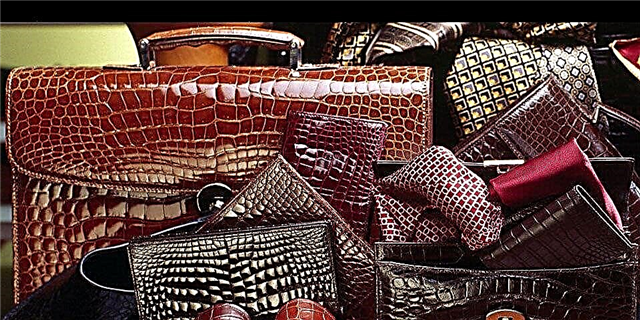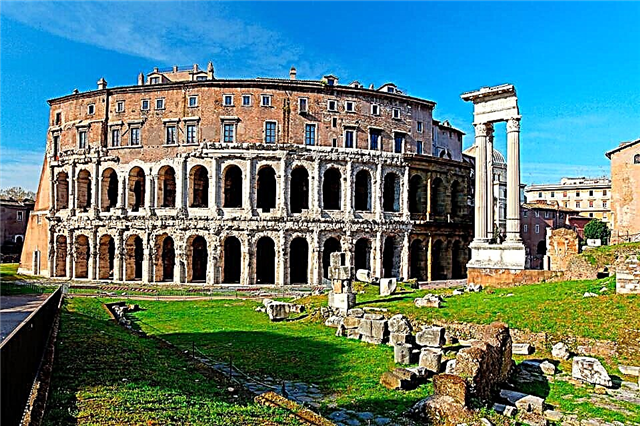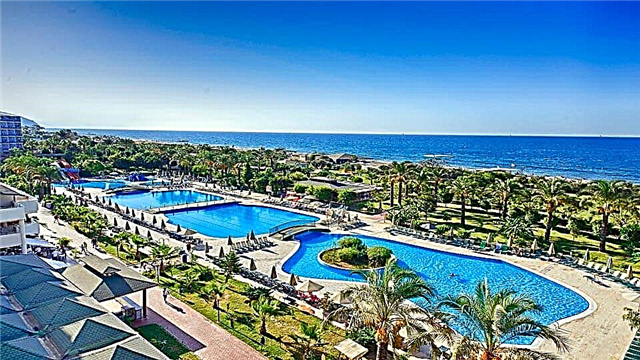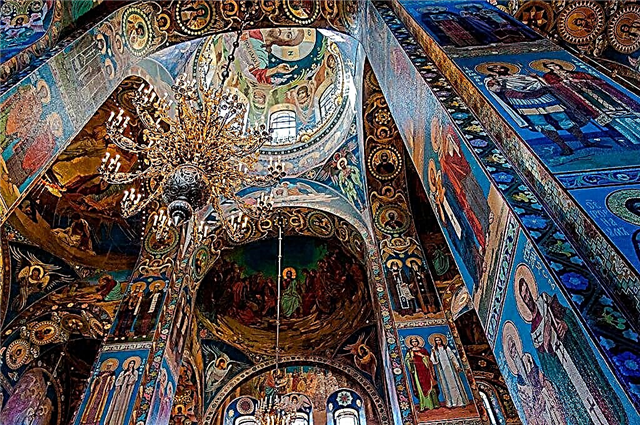The Orthodox Cathedral of the Savior on Spilled Blood in St. Petersburg is a monument to the Russian autocrat Alexander II. Built in the old Russian style, the building gives the impression of fabulousness and exclusivity.
Construction history

On March 1, 1881, Emperor Alexander II was mortally wounded. The very next day after the murder, a commission was created, which began to perpetuate the memory of the tsar-liberator. Before the construction of the church, a small chapel was erected in a very short time - on April 17 of the same year it was consecrated. For its construction funds were allocated by the St. Petersburg merchants of the first guild Gromov and Militin. The chapel was erected at the site of the terrorist attack; it remained there until the construction of the main temple began in the spring of 1883.
Then the building was moved to one of the squares of St. Petersburg, where it stood for almost 10 years, then it was dismantled. A competition for architectural construction projects was announced in 1881. By the end of this year, more than 25 proposals were submitted; famous architects - Benoit, Bogomolov and others took part in it. They were given a large plot of land on both sides of the canal, including in the Mikhailovsky Garden. Eight projects were selected, the best was the work of the architect A.O. Tomishko, named "Father of the Fatherland".
But the king did not finally approve of this option, and a second competition was held, as a result, in 1887, the work of Alfred Parland was approved. After that, the construction of the temple began, which lasted more than 20 years. Consecrated "Savior on Spilled Blood" in 1907. The building was handed over to the St. Isaac's Cathedral Museum as an independent branch in the early 1970s, since 1977 the church has undergone a major restoration for 14 years, and only in 1997, almost a century after the official consecration, it was opened to visitors.
Where did the name come from?
The announcement that the emperor of Russia died from a fatal wound shocked all the inhabitants of the country. As you know, during his reign, there were 7 assassination attempts on Alexander II: they shot five times, a train crash was planned, an explosion in the palace, during which 10 soldiers were killed and almost 80 were wounded from the royal guard. In none of these incidents the emperor was significantly injured, but on the tragic day of March 1, 1881, luck turned away - a bomb thrown by the Narodnaya Volya terrorist I. Grinevsky inflicted a mortal wound on the tsar.
It was a planned and well-prepared act. A preliminary observation of all movements of Alexander II was established. During the passage of the tsar's motorcade along the Catherine Canal, the first bomb was thrown by the revolutionary Rysakov. People were injured from the explosion of the first bomb, including a guard Maleichev, who was accompanying the carriage, and a delivery boy N. Zakharov were fatally injured. The explosion damaged one of the walls of the carriage and knocked out the glass, but the king was not injured and did not immediately leave this place.
He ordered to take care of the wounded, looked at the captured terrorist and was about to continue on his way. At this time, another explosion occurred - the citizen of Narodniy Grinevitsky threw a bomb at the feet of Alexander the Second. The still living emperor was taken on a sleigh to the palace. Alexander II died from mortal wounds in the evening of the same day. A unique architectural monument was erected on the site where the attempt on the life of Emperor Alexander II took place. It is popularly known as the "Savior on Spilled Blood".
The name speaks for itself: Savior is the Savior, and on blood - because it was erected on the place where the blood of the Russian emperor was shed. This cathedral is a monument to the tsar-liberator, built with folk funds. Interestingly, right under the bell tower with a golden dome, a small section of the street and the metal fence of the embankment were left, where the blood of the Russian tsar was shed.
Architecture and interior decoration

The project, somewhat reminiscent of St. Basil's Cathedral, is made in the "Russian style". The magnificent interior of the church, the area of which is more than 7065 sq. m., almost completely decorated with mosaics. Valuable types of stone were used in the decoration. In terms of the richness of decoration and the variety of rocks, shades and texture of marble from Italy and gems brought from the Urals, it is difficult to find a structure equal in beauty.
In the interior decoration, the unique combination of mosaic art and the delicate work of stone cutters is interesting. This is a stone museum, in the construction of which talented foreign and Russian masters took part.
Domes

The church is crowned with a central hip dome and four side onion domes crowned with Orthodox crosses. In the center there is a tent of eight sides. At the base there are eight oblong windows decorated with carved kokoshniks. Five chapters are covered with jewelry enamel, each pattern of the cupola is individual and unique - so the building seems graceful and fabulous. A new technology was used to cover the domes - enamel was applied to the copper plates. Before that, enamels were used only in jewelry. The coverage area exceeds 1 thousand square meters. m.
On the east side, the building is adorned with three graceful gilded domes, set on semicircular apses (building projections of various shapes). In the western part there is a bell tower, which is crowned with the largest dome. The bell tower plays an important role in the architecture of the entire building - this is the place of the assassination of the Russian emperor. According to the architectural concept, the structure somewhat goes beyond the boundaries of the embankment and inside the premises there was a part of the cobbled pavement and the fence, next to which there was a bloodshed. Due to this architectural design, the church lacks a traditional entrance.
The central tent rises 81 meters above the ground - this symbolizes the year of death of the autocrat, the bell dome - 63 meters high - is age, he died a year. The cathedral organically blended into the landscape of the city, although its graceful and light facade looks somewhat alien to the architectural style of the Northern capital.
Appearance

The unique look of the building is created thanks to finishing materials. In the lower part of the basement, dark gray granite is used, the upper part of the columns and arches are made of light granite brought from Lake Ladoga. The drums under the dome, the framing of the windows are made of Estland marble. German brick was used in the cladding. The length of the entire building from east to west is about 56.7 meters, in the central part it is just over 30 meters wide.
The facades are decorated with ornaments used in the architecture of Yaroslavl and Moscow church buildings. In addition, the outer walls are decorated with porcelain and stoneware tiles. They can be seen in the wall, on the roof, in the arches and on the columns. The decoration elements perform not only a decorative function - it contains cult symbols that are often found both in Orthodoxy and in the religions of other nations. One of them is the image of a bud, indicating the origin of the Universe, where the world is the core of the bud.
An Orthodox cross topped with a crown and double-headed eagles indicate that the monument was erected in honor of the Russian autocracy.
Interior decoration

The interior is almost completely covered with mosaic patterns. According to the original plan, the interior was only planned to be painted with paints, including the mosaic only partially in the composition of the facades and icons. It was only in 1895 that a rather extraordinary decision was made - to completely decorate the interior with mosaic decor - before that, this method was used only as a fragmentary decoration of the outer side of the building.
Mosaic fragments were created in the private studio of A.A.Frolov. Paintings made of colorful mosaics fill the entire interior of the temple. The ensemble was created by masters of the mosaic business, sketches were prepared by talented Russian painters.
The interior decoration of the church is unique in the variety and splendor of stone decor, abundance of rocks and many shades of material that was used in construction and decoration. The interior was decorated with Italian marble, amazing design Ural jasper, gems delivered from the Altai region, as well as a variety of rocks - porphyry.
Icons of the "Resurrection of the Lord"

In the construction, a decorative decoration unique for Orthodox churches was used - mosaic icons. The life of Jesus Christ, from Christmas to Ascension, all his deeds, created during his earthly life - everything is reflected in mosaic paintings. There are two images above the golden altar: "The Savior in Strength" and "Christ in Glory". In the center of the altar apse you can see the Eucharist icon. It is interesting to depict Jesus Chris in golden light, giving holy gifts to the Apostles Peter and Paul, bowing before him.
Mosaic icons "Descent of the Holy Spirit" and "Ascension of Christ" are laid out over the iconostasis. In the "Transfiguration of the Lord" mosaic, Christ appears before his followers in a golden divine radiance, and other disciples are all around. On the central vault is the icon "Christ the Almighty", made in the Byzantine tradition. "Savior the Good Silence", "John the Baptist", "The Mother of God" are also executed according to the canons of Byzantine writing.
The iconostasis is made in the classical traditions of easel art. The faces "The Savior" and "The Most Holy Theotokos" are distinguished by their laconic composition, careful execution of images in the complex art of mosaics. To the right of the icon-painting "Savior" is the "Descent into Hell". The image "Prince Alexander Nevsky" is located in the northern icon case, "The Resurrection of Christ" - in the southern one. It is difficult to list all the extraordinary beauty of the work - it is better to see them yourself.
Where is it located and how to get there

Address: nab. Griboyedov, 2.
- Metro.
The nearest metro stations are “Nevsky Prospekt”, from which you have to walk about 500 m. From “Kanale Griboyedov” it is about 150 m further.
- By bus number 27, 22, 7, 3
- By trolleybus No 22, 11, 10, 7, 5, 1
Visiting times and opening hours
Open daily, closed on Wednesdays.
Opening hours: from 10:30 to 18:00.
Ticket office hours: until 17:00.
The duration of the excursion is from 18:00 to 22:00.
Entrance ticket price:
- adults - 250 rubles
- children from 7 years old, students and pensioners - 50 rubles.
- evening excursion - 400 rubles.
- evening excursion (from early May to late September) - 400 rubles.
- children under 6 years old admit free
The Cathedral of the Resurrection of Christ is one of the 10 most significant and famous architectural monuments of the Northern capital. Hundreds of thousands of tourists visit the temple every year to admire the interior decoration and graceful facade of the building.











